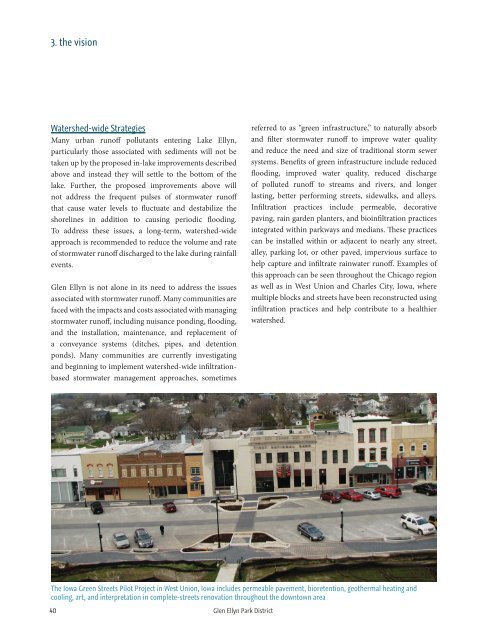Lake Ellyn Park 2013 Master Plan
Lake Ellyn Master Plan Final - Glen Ellyn Park District
Lake Ellyn Master Plan Final - Glen Ellyn Park District
- No tags were found...
You also want an ePaper? Increase the reach of your titles
YUMPU automatically turns print PDFs into web optimized ePapers that Google loves.
3. the vision<br />
Watershed-wide Strategies<br />
Many urban runoff pollutants entering <strong>Lake</strong> <strong>Ellyn</strong>,<br />
particularly those associated with sediments will not be<br />
taken up by the proposed in-lake improvements described<br />
above and instead they will settle to the bottom of the<br />
lake. Further, the proposed improvements above will<br />
not address the frequent pulses of stormwater runoff<br />
that cause water levels to fluctuate and destabilize the<br />
shorelines in addition to causing periodic flooding.<br />
To address these issues, a long-term, watershed-wide<br />
approach is recommended to reduce the volume and rate<br />
of stormwater runoff discharged to the lake during rainfall<br />
events.<br />
Glen <strong>Ellyn</strong> is not alone in its need to address the issues<br />
associated with stormwater runoff. Many communities are<br />
faced with the impacts and costs associated with managing<br />
stormwater runoff, including nuisance ponding, flooding,<br />
and the installation, maintenance, and replacement of<br />
a conveyance systems (ditches, pipes, and detention<br />
ponds). Many communities are currently investigating<br />
and beginning to implement watershed-wide infiltrationbased<br />
stormwater management approaches, sometimes<br />
referred to as “green infrastructure,” to naturally absorb<br />
and filter stormwater runoff to improve water quality<br />
and reduce the need and size of traditional storm sewer<br />
systems. Benefits of green infrastructure include reduced<br />
flooding, improved water quality, reduced discharge<br />
of polluted runoff to streams and rivers, and longer<br />
lasting, better performing streets, sidewalks, and alleys.<br />
Infiltration practices include permeable, decorative<br />
paving, rain garden planters, and bioinfiltration practices<br />
integrated within parkways and medians. These practices<br />
can be installed within or adjacent to nearly any street,<br />
alley, parking lot, or other paved, impervious surface to<br />
help capture and infiltrate rainwater runoff. Examples of<br />
this approach can be seen throughout the Chicago region<br />
as well as in West Union and Charles City, Iowa, where<br />
multiple blocks and streets have been reconstructed using<br />
infiltration practices and help contribute to a healthier<br />
watershed.<br />
The Iowa Green Streets Pilot Project in West Union, Iowa includes permeable pavement, bioretention, geothermal heating and<br />
cooling, art, and interpretation in complete-streets renovation throughout the downtown area<br />
40 Glen <strong>Ellyn</strong> <strong>Park</strong> District




